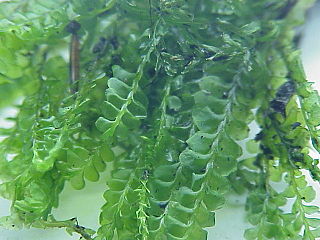
Marchantiopsida is a class of liverworts within the phylum Marchantiophyta. The species in this class are known as complex thalloid liverworts. The species in this class are widely distributed and can be found worldwide. Complex oil bodies are only found in the gametophyte.

Lunularia is a genus of liverworts whose only species is Lunularia cruciata, the crescent-cup liverwort. Lunularia is either the only genus in the order Lunulariales, or may be placed in the order Marchantiales. The name, from Latin luna, moon, refers to the moon-shaped gemma cups.

Lepidoziaceae is a family of leafy liverworts. It is a group of small plants that are widely distributed.

Plagiochila is a large, common, and widespread genus of liverworts in the order Jungermanniales. It is a member of the family Plagiochilaceae within that order. There may be anywhere from 500 to 1300 species, most of them from the tropics; the exact number is still under revision.
Herbertus is a genus of liverworts in the family Herbertaceae. The genus has a broad global or cosmopolitan distribution, including sixteen species that occur in Eurasia:

Schistochila is a genus of liverworts in the order Jungermanniales. It is the only genus in the family Schistochilaceae.
The family Jubulaceae is a family of liverworts. The family name is derived from the genus Jubula.

Radula is a genus of liverwort in the family Radulaceae. The genus includes 248 species of small plants that typically grow as green, scaly patches on tree trunks, logs, or rocks in moist environments. It is distinguished from other liverworts by several unique features, including the production of root-like structures (rhizoids) exclusively from leaf surfaces and characteristic branching patterns. The plants have rounded, overlapping leaves consisting of two unequal lobes, with considerable variation in structure across species. Following a major taxonomic revision in 2022, the genus comprises five subgenera with distributions ranging from tropical to temperate regions. The oldest known fossil species, R. cretacea, found in Burmese amber, dates to the Cenomanian age, though molecular evidence suggests the genus originated in the Triassic period, around 228 million years ago.
Colura is a genus of epiphytic type of liverworts and consists of approximately 80-90 species, that are distributed generally in the tropics.

Antheliaceae is a monotypic liverwort family in the order Jungermanniales. It contains a single genus, Anthelia.

Conocephalum conicum, also known as the great scented liverwort or snakeskin liverwort, is a liverwort species in the genus Conocephalum. C. conicum is part of the Conocephalum conicum complex, which includes several cryptic species. The name C. conicum refers to the cone-shaped archegoniophore, which bear sporangia.

Marsupella is a liverwort genus in the family Gymnomitriaceae.

Metzgeria furcata, the forked veilwort, is a frequent liverwort growing on the bark of a wide range of tree and shrub species and occasionally on rocks. It is a slim, translucent thallose liverwort that forms yellow-green mats of branches about 1mm wide.

Cephalozia is a genus of liverworts belonging to the family Cephaloziaceae.

Lophozia is a genus of liverworts belonging to the family Lophoziaceae. The genus was first described by Barthélemy Charles Joseph Dumortier.
Odontoschisma is a genus of liverworts belonging to the family Cephaloziaceae.

Trichocolea is a genus of liverworts belonging to the family Trichocoleaceae.

Lophocolea is a genus of liverworts belonging to the family Lophocoleaceae. The genus has a cosmopolitan distribution.

James Needham was an English mycologist and iron moulder from Hebden Bridge, Yorkshire. He was a founding member of the British Mycological Society. Notable for his working-class status, Needham became one of the foremost collectors of fungi and bryophytes in the UK.
Lepicolea is a genus of liverworts belonging to the family Lepicoleaceae.















